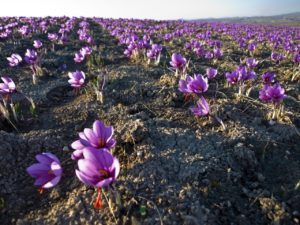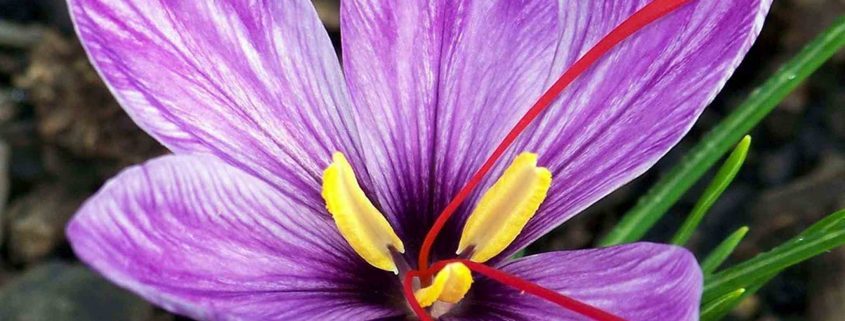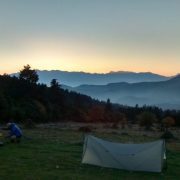Listen to the Greek text, improve your listening skills, while learning more about Saffron.
Saffron is a delicious spice coming from the Krokos (crocus) flower, is growing in Greece and known since ancient times! Saffron is being used in many different ways: for its flavor in the kitchen, for its color in cosmetics and paint, for its healing properties in the pharmaceutical sector. Cleopatra saw the value of using saffron in cosmetics, in the Old Testament, it was mentioned because of its essence and Aeschylus described it as a way to dye fabric.
Click here and listen to the Greek text
Below you find the translation in English
A bit of Greek Mythology
The Ancient Greeks explained the existence of saffron, this wonderful product of nature, with a myth: Krokos (The name for Saffron in Greek) was a young Spartan and friend of God Hermes. One day, the two friends were playing. While playing, Hermes hit his friend Krokos by accident on the head and he died. At the place he died a flower grew, symbolizing the body of Krokos. Three drops of his blood fell in the center of the flower and these drops became its stigmata. Ever since the flower is called Krokos, and the stigmata give us the famous saffron.
Furthermore, also Homer referred to this ‘gold of the Greek earth’ in his Iliad: “The Sunrise drew her crocus-like scarf over the sea to bring light on Gods and men alike.”
Cultivation
The kind of saffron that is being cultivated now, is named scientifically “Crocus Sativus Linneaus”.
The finished product is highly used in the culinary, medicinal and cosmetic markets all over the world. Iran and Spain also produce Saffron but Greek saffron is regarded as the finest in the world.
Although it is known that the ancient Minoans cultivated saffron during Late Bronze Age in Crete, the cultivation afterward disappeared from Greece. In the 17th C. Greek Macedonian traders brought the plant from Austria to the region of Kozáni, in Northern Greece. It is a unique area of about 3000 acres consisting of 40 small villages, called Krokohória (= the crocus villages). The ideal climatic and soil conditions of this area in Greece have allowed krokos-saffron to be exclusively cultivated there for the last 300 years. Nowadays more or less 1.2 to 2 ton of Red Saffron is produced per year.
Harvest
The flower harvest time starts around half October and is very hard work. The use of spades or tractors are strictly forbidden in such  a delicate crop. Workers have to pick all the flowers by hand! After that, the stigmas (the actual saffron) have to be taken from the heart of the flower and to be dried carefully, so as to preserve all its qualities and color. After the drying process, the stigmas of crocus would have 1/5 of their original size. This means that for 1 kg of raw stigmas we will obtain 200 g of crocus – saffron ready for consumption. The fact that more than 85.000 flowers are needed to obtain just one kilo of crocus gives us an idea of how hard this work is!
a delicate crop. Workers have to pick all the flowers by hand! After that, the stigmas (the actual saffron) have to be taken from the heart of the flower and to be dried carefully, so as to preserve all its qualities and color. After the drying process, the stigmas of crocus would have 1/5 of their original size. This means that for 1 kg of raw stigmas we will obtain 200 g of crocus – saffron ready for consumption. The fact that more than 85.000 flowers are needed to obtain just one kilo of crocus gives us an idea of how hard this work is!
As a traveler in Greece, Autumn is the perfect time to spend some days in Krokohória and live the unique experience of harvesting precious spice. It takes place between late October and early November.
Greece produces many exclusive herbs and spices in various regions, another good example is Mastiha. The trees producing it, are growing on the island of Chios.
++++++++++++++++++++++++++++++++++
Do you want to immerse yourself in the Greek language and improve your reading and listening skills?
Then the « Ultimate Listening Comprehension eBook » might be what you are looking for.
This eBook contains the entire Greek text of the English translation here above, as well as another 8 texts, all related to Greece and Greek culture.
On top of that, the Audio-mp3 files are included, so you can listen to a native Greek speaker while improving your listening skills in Greek.
The eBook is perfect to improve your reading and listening skills, especially if you are an intermediate-advanced student.
Ready to read the entire article in Greek, and listen to the Greek Audio-file? Then click here for more info about the eBook.









